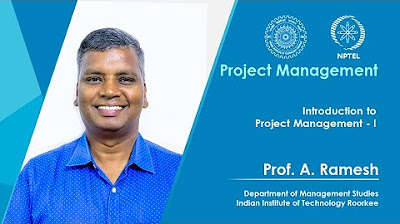What Is Risk Management In Project Management? All you need to know...
Summary
TLDRThis video delves into the importance of risk management in project management. It covers the process of identifying, analyzing, planning, and acting on risks to ensure project success. The video explains key activities such as assessing risk likelihood, impact, and developing strategies to mitigate or avoid risks. It also highlights the benefits of risk management, such as increased control, fewer surprises for stakeholders, and better data-driven decisions. Through examples like a coffee shop or an outdoor activity center, the video illustrates how practical risk management strategies can be applied in real-world scenarios.
Takeaways
- 😀 Risk management in project management helps identify, analyze, and manage risks to ensure a successful project outcome.
- 😀 The risk management process involves identifying, analyzing, planning, and taking action on risks to minimize their impact or likelihood.
- 😀 Risk identification is the first step in risk management, where potential risks are spotted across scope, cost, and quality.
- 😀 Analyzing risks involves evaluating their likelihood of occurrence and potential impact on the project.
- 😀 Planning responses to risks involves developing strategies to address them, ensuring a well-thought-out approach before taking action.
- 😀 Taking action involves implementing risk management strategies, such as reducing, avoiding, or transferring risks.
- 😀 Key activities in risk management include identifying risks, analyzing their probability and impact, planning responses, and tracking and monitoring risks.
- 😀 There are several strategies to manage risks, such as removing the risk, reducing its impact or likelihood, transferring it, or accepting it.
- 😀 Tools for managing risk include risk management plans, risk registers, project management software, and communication tools like Microsoft Teams or Excel.
- 😀 Risk management provides benefits like better visibility for stakeholders, improved decision-making, and reduced uncertainty in project outcomes.
- 😀 Real-world examples of risk management include choosing a high-foot-traffic location for a coffee shop or setting aside cash reserves for weather-dependent businesses.
Q & A
What is the main purpose of risk management in project management?
-The main purpose of risk management is to ensure a successful project outcome by reducing threats and increasing opportunities. It involves anticipating potential issues and putting strategies in place to manage and mitigate risks effectively.
Why is risk management important for projects?
-Risk management is crucial because projects are inherently risky. By identifying and managing risks, project managers can stay in control, respond to uncertainties, and minimize potential negative impacts on the project's success.
What are the four general steps in the risk management process?
-The four steps in the risk management process are: 1) Identifying risks, 2) Analyzing risks, 3) Planning responses, and 4) Taking action based on the planned strategies.
What are some key activities a project manager should undertake in risk management?
-Key activities include identifying risks, assessing their probability and impact, planning responses, tracking and monitoring risks, and communicating risks and responses to stakeholders.
What are the different strategies for managing risks?
-The strategies include: 1) Removing the risk entirely, 2) Reducing the likelihood of the risk occurring, 3) Reducing the impact of the risk, 4) Transferring the risk to a third party (e.g., insurance), 5) Creating contingency plans, and 6) Accepting the risk and managing its outcome.
What is a risk management plan?
-A risk management plan is a document that outlines the entire risk management process for a project or organization. It is typically created at the beginning of a project and may be updated throughout its duration to address new risks.
What is a risk register, and how does it help a project manager?
-A risk register, or risk log, is a repository where all identified risks are documented, analyzed, and tracked. It helps project managers prioritize risks, understand their potential impact, and monitor the effectiveness of the mitigation strategies.
How do tools like Microsoft Excel or project management software support risk management?
-Tools like Microsoft Excel or project management software (e.g., Smartsheet) help create and maintain risk registers, log risks, and analyze data. They provide a platform to document risks, assess their impacts, and facilitate communication with stakeholders.
What are some benefits of effective risk management in project management?
-Benefits include easier identification of troubled projects, fewer surprises for stakeholders, better data quality for decision-making, clear expectations, and better control over project outcomes. It also improves decision-making and reduces uncertainty.
Can you provide an example of risk management in a real-world scenario?
-One example is a coffee shop opening a new location. The business might mitigate risks by choosing a location with high foot traffic and fewer competitors. Another example is an outdoor activity center, which manages weather-related risks by setting aside cash reserves for bad seasons.
Outlines

This section is available to paid users only. Please upgrade to access this part.
Upgrade NowMindmap

This section is available to paid users only. Please upgrade to access this part.
Upgrade NowKeywords

This section is available to paid users only. Please upgrade to access this part.
Upgrade NowHighlights

This section is available to paid users only. Please upgrade to access this part.
Upgrade NowTranscripts

This section is available to paid users only. Please upgrade to access this part.
Upgrade NowBrowse More Related Video

AP 10 ONLINE LECTURES: Aralin 8 "Community-Based Disaster Risk Management (CBDRM)"

Lecture 01: Introduction to Project Management - I

CH05. L02. Test planning overview

ISTQB FOUNDATION 4.0 | Tutorial 50 | Risk Identification | Risk Assessment | CTFL Tutorials

Project Management Resource Scheduling session 6

Risk Management Basics | Google Project Management Certificate
5.0 / 5 (0 votes)